Art 101: Ancient Art Part 2 – Ancient Egypt, Greece and Rome

Part 2 of the first instalment in the Art 101 series
In this post we will look at the ancient art from three of the most advanced and celebrated ancient civilisations in Western Art history, spanning across Europe and just across the sea to the continent of Africa. We will look at Ancient Greece, Ancient Rome and Ancient Egypt, to contrast how the artistic growth in these civilisations differs from those we have already seen.
Ancient Egypt
Ancient Egyptian art is any art created in Egypt between the 6000 BC and roughly 400 AD. In Egypt, there exists a long tradition of figurative imagery since the beginning of recorded history, with Ancient Egyptian civilisations using pictures as a form of complex early written communication, the heiroglyph.
Heiroglyphs themselves can arguably be seen as not only a language, but an art form, with intricately decorated figures of humans animals and objects used to denote words and phrases.
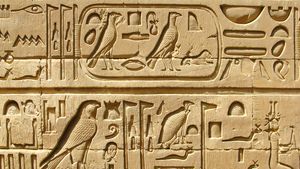
Example of hieroglyphics from the Temple of Ombos
Stone carving was not limited to writing and record keeping, and early Egyptian society was known for it’s decorative carvings and stonework, both on the sphinxes and pyramids that are so famous now, and still surviving, but also in the monumental figurative carvings displayed outside notable tombs of pharaohs and other members of Egyptian aristocracy.
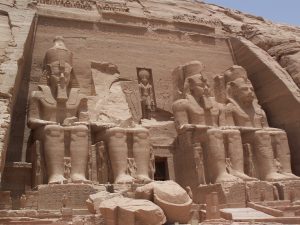
Abu Simbel, Temple of Ramesses II
In early Egypt, much like other contemporaneous civilisations, there is evidence of clay working – not only for functional objects but also highly decorative artistic objects such as the bird-like jug depicted below.
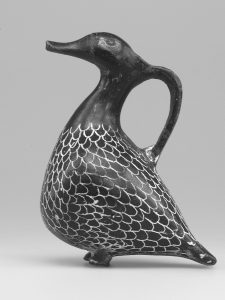
An example of Egyptian Tell el-Yahudiyeh Ware pottery
Much like we saw in our previous visit to the Bronze and Iron Ages, the Egyptians were also skilled at metalwork. From very early on in Egyptian history, we see small decorative metalwork like this tiny golden scarab beetle, a sacred animal in Ancient Egypt.

Scarab, circa 1980 BC, gold
Of course, the Egyptians rapidly progressed to some of the most beautiful examples of intricate gold and silver decoration, both solid, cast and gilded, that we have examples of to this day. Namely, in the form of mummy masks, or gilded plaster (and occasionally solid gold) shells or adornments for the mummified bodies of Pharaohs and people of importance who had passed away.
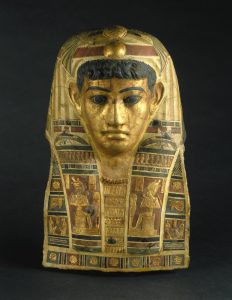
Mummy mask of a man; early 1st century AD; stucco, gilded and painted
It is also with Egypt that we see our first painted work of the series, in the form of this ancient wall painting, showing people bringing presents to the tomb of their leader.
Syrians bringing presents to Tuthmosis III, in the tomb of Rekhmire, circa 1450 BCE
An overwhelming theme to Egyptian art, save for the pottery perhaps, is a desire to celebrate and venerate the Pharaohs and leaders of their society through decoration. We find countless examples of Egyptian art dedicated to their many gods, however Pharaohs and persons of importance within their contemporary society seem to be nearly on the same level of worship, with many of the above examples hailing directly from these tombs.
Ancient Greece
In Ancient Greek art, we see a much more certain focus on the gods, and not the living man, in their art. In the West, our entire history of art has been shaped irrevocably by a desire to study and emulate the ‘classics’ and Ancient Greece is in fact this original ‘classic’. Once the epicentre of established civilisation, it is indeed the Greek tradition which the Romans and all who came after borrowed from.
When one hears the term ‘Ancient Greek Art’, it is definitely figurative marble sculptures which come to mind, depictions of myth, legend and gods, crafted with beauty and grace from polished white stone.
These works depict stories of Greek myth such as Helen of Troy, allegories such as figurative expressions of virtues such as grace, and Greek gods such as Zeus and Aphrodite.
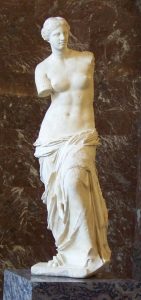
The Venus de Milo, 130-100 BC
However, as skilled as the Greeks were, it was not only marble from which they sought to create these beautiful, idealistic bodies. The Artemision Bronze shows the same attention to beauty and anatomical proportion in a monumental bronze man which stands at over 2m high.
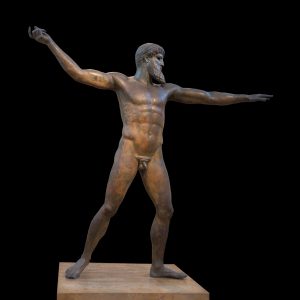
The Artemision Bronze, either Poseidon or Zeus, c. 460 BC
Another popular form of artistic decoration in the Ancient Greek era was pottery. Pottery in Ancient Greece is divided roughly into three periods – the Geometric, the Black Figure and the Red Figure, which is quite self explanatory within the works. The Geometric period presents works with attention to shape and line, the Black Figure pottery shows dark figures on a red background, while the Red Figure era shows this in reverse.
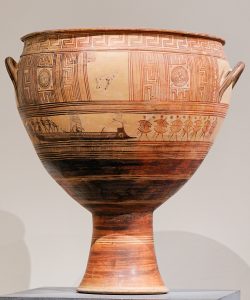
Geometric: Krater, c. 800-775 BC
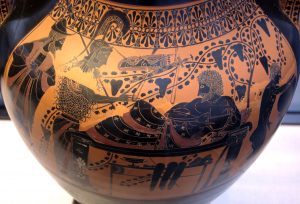
Black Figure: Heracles and Athena, c. 520/510 BC
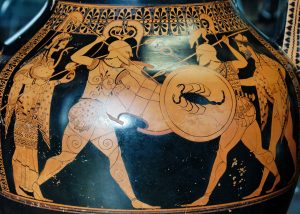
Red Figure: Warriors, flanked by Hermes and Athena, c. 530 BC
Many other styles of pottery came in between and preceding these two, however these styles were the most prominent.
In Ancient Greece we also see the rise in popularity of two art forms which will be repeated in the Roman era – painting and mosaics.
In painting we see a huge interest in polychromy – the use of many bright colours which have impressively held their vibrancy over hundreds, even thousands of years. Most of the remaining painted works from this era are frescoes, that is, paintings applied directly onto wet plaster. This is quite a sturdy medium, as the paint or pigment dries to become an integral part of the wall. The paintings from Ancient Greece show an outstanding attention to detail and interest in naturalistic depictions.
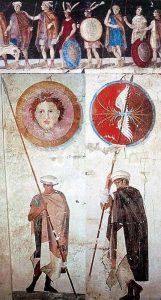
Macedonian tomb fresco from Agios Athanasios, Thessaloniki, Greece, 4th century BC
The mosaics also are a delight in human figure and form, such as the example below of hunters which is thought to show Alexander the Great and his friend and possible lover, Hephaestion.
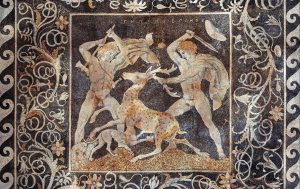
The Stag Hunt Mosaic, late 4th century BC
Again we see huge attention to detail, and an interest in the human figure that was adopted by and built upon by the Ancient Romans.
Ancient Rome
The art of Ancient Rome was heavily influenced by the Ancient Greeks in its delight in depictions of a naturalistic human form, and while the Romans did create art celebrating their gods and their mythology, we also here see perhaps a stronger agenda similar to the Ancient Egyptians in that the Romans sought primarily to venerate their living Emperors and to further the reaches and influence of their empire through their art.
Following on from the Greeks, examples of this can be found in paintings, sculpture and mosaic, such as in the examples below.
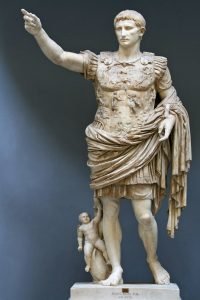
Augustus of Prima Porta, statue of the emperor Augustus, 1st century AD
A lot of Ancient Roman sculpture deals with Emperors and great military leaders, such as the statue above of Augustus, a famed leader of the Roman Empire. At this time, Rome held huge influence over the globe and their Empire spanned over most of Europe and parts of the East.
Similar depictions of Augustus and other emperors can be found across a wide variety of carved media, even jewellery, as seen in this beautiful example of a Roman cameo below.
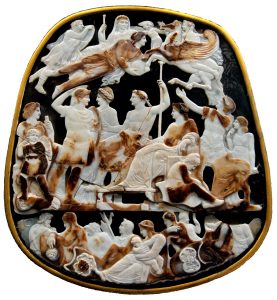
The cameo gem known as the “Great Cameo of France”, c. 23 AD, with an allegory of Augustus and his family
Mosaics and painting were also an integral part of Roman life, from palatial to domestic. Some of the best preserved examples of these can be found in the tragic town of Pompeii, which was consumed by an erupting volcano, Mount Vesuvius in AD 79. Huge restorative and archaeological work has occurred at this site to unearth the city from the ruins. While an absolute tragedy for the loss of life it brought, the volcanic debris has allowed this city to remain somewhat preserved and untouched throughout history, providing historians with an invaluable insight into regular Roman life (there have even been discoveries of some hilarious street graffiti…. lets just say that the Romans were not so dissimilar to ourselves, and they were quite prolific in drawing certain… body parts or appendages…. everywhere!)
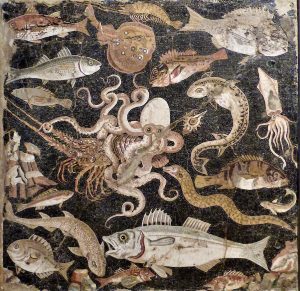
Sea creature mosaic, originally in the House of the Faun, Pompeii, 1st Century AD
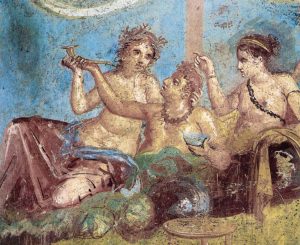
Roman fresco with a banquet scene from the Casa dei Casti Amanti, Pompeii
The above scenes differ from the aforementioned celebratory imperial works, and instead show scenes from Roman mythology. Their shift in focus is due to their purpose – works such as these were intended not for city spectacle but for a domestic setting – for example, the mosaic could have been reminiscent of a familys fishing past or have some oceanic meaning, and the painted banquet scene was no doubt in an area where feasts and copious wine drinking could have taken place at festivities.
Of course we must not miss what people tend to call the “minor” arts when talking about Ancient History – because it is actually in these small things that are often not thought of as art that we see some of the most intricate skill and decoration.
Roman coins are an excellent example of this. There were numerous different types of coins in Ancient Rome, and they were incredibly common – nowadays they are one of the most widely reported amateur archaeological finds in areas that once made up the Roman Empire.
While these coins are indeed beautiful in their own right, their place as an art historical object is also of incredible importance. Due to the fact that Emperors wanted above all else to show their subjects their importance and wealth, they often minted portraits of themselves into the coinage. These coins can show us approximations of what these leaders may have looked like, which helps us to visualise the leaders – and even match them to marble busts that were found from this period – some coins have even helped in identifying these busts.
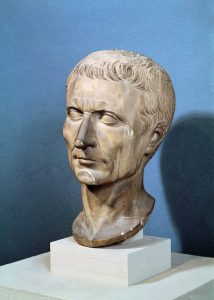
Roman bust of Julius Caesar, c. 100 BC
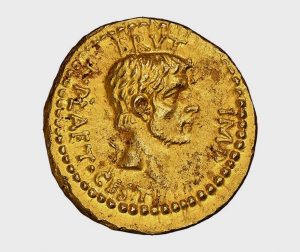
Coin showing Julius Caesar
Furthermore, coins such as this one, minted during the rule of Augustus, can show us lost buildings, like the The Temple of Mars Ultor, which was built in 20 BCE (right).
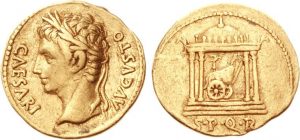
Coin showing Augustus and The Temple of Mars Ultor
Of course – lost buildings, and even Roman, Greek and Egyptian architecture is a whole other topic in its own right, every bit as fascinating as the mainstream art of the era. But maybe that’s one for the next series…
Join us next time, when we’ll be exploring Insular Art, and illuminated manuscripts from the Early Christian Period!







